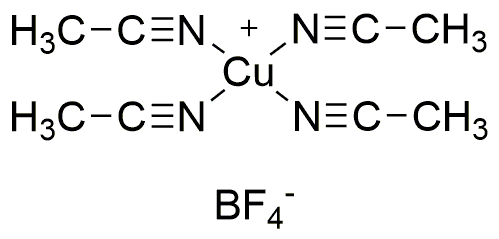Tetrakis(acetonitrile)copper(I) tetrafluoroborate is widely utilized in research focused on:
- Catalysis: This compound serves as an effective catalyst in various organic reactions, enhancing reaction rates and improving yields, particularly in cross-coupling reactions.
- Electrochemistry: It is used in electrochemical studies, where its unique properties allow for the investigation of electron transfer processes, making it valuable for battery and fuel cell research.
- Material Science: The compound plays a role in the synthesis of novel materials, including conductive polymers and nanomaterials, which are essential for developing advanced electronic devices.
- Coordination Chemistry: Researchers utilize it to explore coordination compounds, aiding in the understanding of metal-ligand interactions, which is crucial for designing new catalysts and sensors.
- Pharmaceutical Development: Its applications extend to drug formulation, where it can be involved in the synthesis of biologically active compounds, contributing to the development of new therapeutic agents.
General Information
Properties
Safety and Regulations
Applications
Tetrakis(acetonitrile)copper(I) tetrafluoroborate is widely utilized in research focused on:
- Catalysis: This compound serves as an effective catalyst in various organic reactions, enhancing reaction rates and improving yields, particularly in cross-coupling reactions.
- Electrochemistry: It is used in electrochemical studies, where its unique properties allow for the investigation of electron transfer processes, making it valuable for battery and fuel cell research.
- Material Science: The compound plays a role in the synthesis of novel materials, including conductive polymers and nanomaterials, which are essential for developing advanced electronic devices.
- Coordination Chemistry: Researchers utilize it to explore coordination compounds, aiding in the understanding of metal-ligand interactions, which is crucial for designing new catalysts and sensors.
- Pharmaceutical Development: Its applications extend to drug formulation, where it can be involved in the synthesis of biologically active compounds, contributing to the development of new therapeutic agents.
Documents
Safety Data Sheets (SDS)
The SDS provides comprehensive safety information on handling, storage, and disposal of the product.
Product Specification (PS)
The PS provides a comprehensive breakdown of the product’s properties, including chemical composition, physical state, purity, and storage requirements. It also details acceptable quality ranges and the product's intended applications.
Certificates of Analysis (COA)
Search for Certificates of Analysis (COA) by entering the products Lot Number. Lot and Batch Numbers can be found on a product’s label following the words ‘Lot’ or ‘Batch’.
Numéro de catalogue
Numéro de lot/série
Certificates Of Origin (COO)
This COO confirms the country where the product was manufactured, and also details the materials and components used in it and whether it is derived from natural, synthetic, or other specific sources. This certificate may be required for customs, trade, and regulatory compliance.
Numéro de catalogue
Numéro de lot/série
Safety Data Sheets (SDS)
The SDS provides comprehensive safety information on handling, storage, and disposal of the product.
DownloadProduct Specification (PS)
The PS provides a comprehensive breakdown of the product’s properties, including chemical composition, physical state, purity, and storage requirements. It also details acceptable quality ranges and the product's intended applications.
DownloadCertificates of Analysis (COA)
Search for Certificates of Analysis (COA) by entering the products Lot Number. Lot and Batch Numbers can be found on a product’s label following the words ‘Lot’ or ‘Batch’.
Numéro de catalogue
Numéro de lot/série
Certificates Of Origin (COO)
This COO confirms the country where the product was manufactured, and also details the materials and components used in it and whether it is derived from natural, synthetic, or other specific sources. This certificate may be required for customs, trade, and regulatory compliance.


